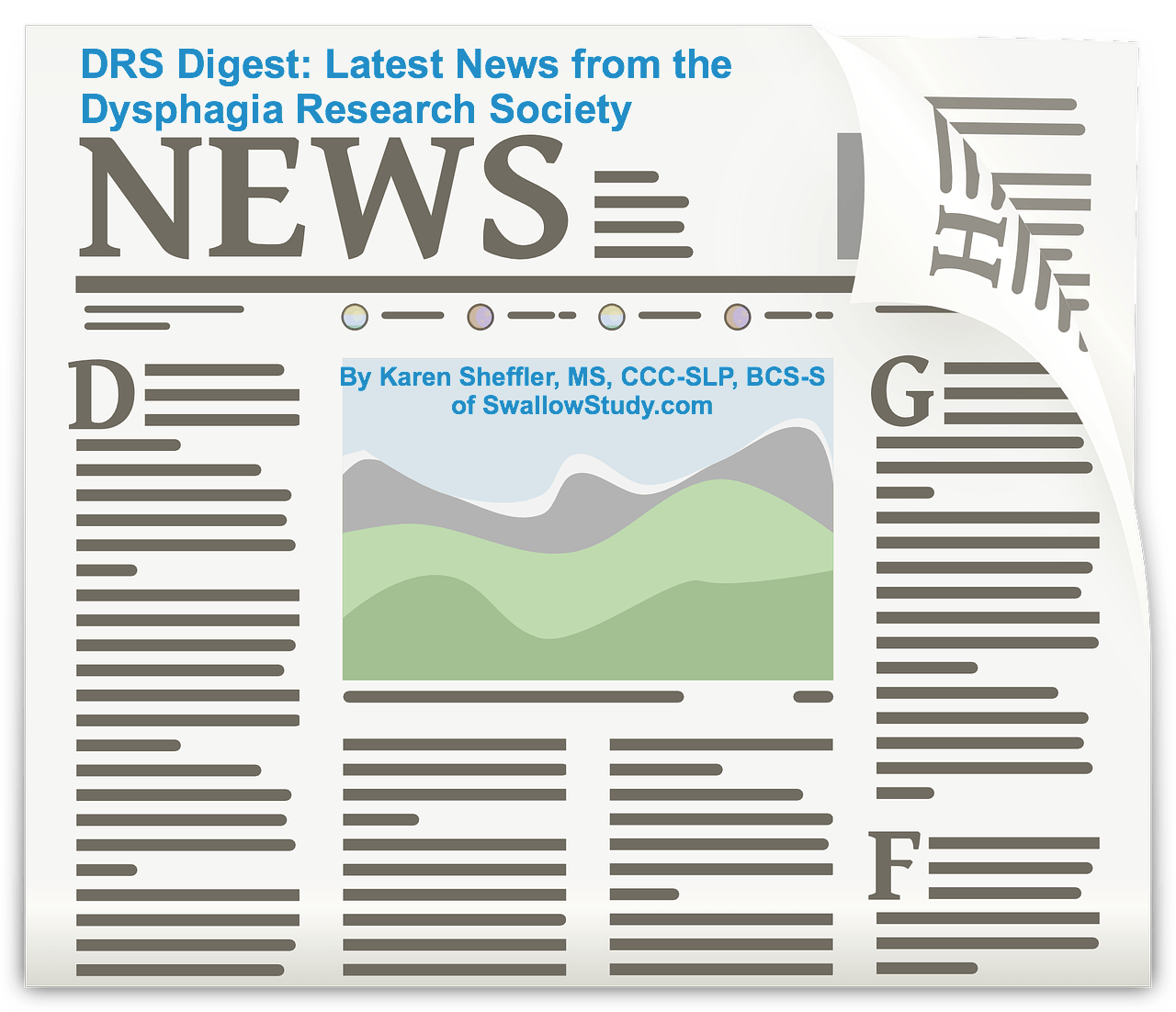The field of dysphagia is young, and every year the Dysphagia Research Society’s (DRS) Annual Meeting and Post-Graduate Course provide a wealth of exciting new research. You may be following #DRS2016 on Twitter (scroll past the Dr Seuss day tweets using our hashtag). Have you also checked out the Facebook posts by @DysphagiaResearchSociety and @SwallowStudySLP?
This DRS Digest will share more highlights that may affect how you practice tomorrow and in the future.
Just last week, I used information that I learned at #DRS2016 when counseling a patient who is experiencing the late-effects of radiation causing dysphagia and xerostomia. He immediately related to Nicole Rogus-Pulia’s poster and findings, showing that his sticky saliva is actually thicker. Rogus-Pulia and team showed a negative association between salivary viscosity and salivary quantity. She found when patients had lower quantities of saliva (unstimulated), they had higher apparent salivary viscosity. This thicker saliva is associated with more swallow effort and more oropharyngeal residue. Additionally, this higher viscosity saliva is harder to clear from the airway.
As I share some of the take-home messages from #DRS2016, please think about and share what news you are taking back to your job and career.
7 Swallowing Summaries from Dysphagia Research Society:
1. Defining the term: “SCREEN”
Frequently, our Comprehensive Dysphagia Assessment (aka, Clinical Bedside Swallowing Evaluation) has been called a screen, or at best a “bunch of screens.” This has been controversial. The term screen was defined and clarified several times this year at DRS.
Dr Giselle Carnaby, MPH, PhD, FASHA (author of the Mann Assessment of Swallowing Ability or MASA) started off our post-graduate course with the talk: Promoting Evidence and Standards in Clinical Assessment.
A screen recognizes a problem in a non-referred population, prior to the patient being symptomatic. A screen detects a problem (e.g., suspected aspiration on water) when the patient is in a pre-clinical phase. Once a potential difficulty swallowing is detected, immediate access to a diagnostic workup with a Comprehensive Dysphagia Assessment will alter the treatment and the patient’s outcomes. “Our clinical examination is more than just a simple screen,” stated Dr Carnaby; it “incorporates YOUR skills.”
Dr Carnaby listed the following reasons why our assessment is different from a screen:
- Longer and more comprehensive
- More than just an observational checklist
- Focus on underlying pathophysiology. She suggests to relate the symptoms (patient/staff/caregiver reports) to the clinical signs noted (clinician observations). The clinician should discuss the suspected physiological nature of the patient’s swallow in relation to the patient’s medical and swallow history. This need for thoroughness in our chart review and interview with the patient, caregivers and medical team points to the fact that what we do is more than a screen.
- Tailored to the patient and the disorder (“specific goals and methods may vary between cases and disorder types,” per Carnaby).
- Not just reporting signs. You need to interpret them. The examination should be supported by research as reliable and valid, and it is rooted in theory to allow this interpretation (i.e., MASA).
- Predicts the presence and suspected severity of the dysphagia and aspiration. Represent the real world and discuss risk.
- Inventory of dysphagia-related deficits.
- Not just about impairments (there is an over-focus on aspiration, per Carnaby), but also determining the remaining functional swallowing and feeding abilities and potential for modifications.
- Includes direction for instrumental examinations and formulation of a preliminary treatment plan.
Dr Cheril Canon, Radiologist called the term “screen,” an inflammatory term. She clarified that when we do an esophageal sweep during a videofluoroscopic swallow study (aka, modified barium swallow study), we really should not be calling that an “esophageal screen.” Again, she noted that a screen is finding an undiagnosed issue in a normal population. However, the patient receiving the videofluoroscopic swallow study has already been referred due to an identified potential dysphagia. Canon understood that we need to check esophageal clearance and rule-out retrograde flow that could cause aspiration after the swallow. She stated that this is a “purely therapeutic” check of esophageal emptying. She noted that if you want to really evaluate the esophagus, you need to do a full barium swallow study.
2. Standardizing the Videofluoroscopic Swallow Assessment in Bottle-Fed Children:
Dr Maureen Lefton-Greif, PhD, CCC-SLP, BCS-S of Johns Hopkins University School of Medicine and Dr Bonnie Martin-Harris, PhD, CCC-SLP, BCS-S, ASHA Fellow of MUSC have teamed up to create a standardized tool for infants and children to measure physiology, structure, bolus movements, and airway protection.
This is big news! The need for standardization in infant instrumental assessments was a hot topic of DRS 2015 as well.
Adult experience in the MBSImP does not automatically translate to bottle-fed infants and children. Better diagnostic examinations and faster recognition of feeding and swallowing problems in infants and children will improve “survival rates of children with complex and medically fragile conditions,” stated Lefton-Greif. They created 24 components across functional domains such as: Nutritive Sucking/Oral Containment & Transport, Pharyngeal Swallow Initiation, Pharyngeal Containment and Clearance, Airway Protection, and PE Opening/Esophageal Clearance. In their reliability testing, they realized that the tool will need training with precise definitions to increase reliability. Even raters with more experience required this training. Seven SLPs performed 3 training sessions, and they reached at least an 80% agreement in rating the components. They noted that the nutritive sucking and airway-related components were the most difficult to quantify.
The researchers are working on further defining which components are essential to clinical outcomes. This is not ready to use tomorrow, but it is coming!
3. Neonatal Feeding Assessment Scale (NFAS):
Mari Viviers, M Comm Path (SLT), sDPhil of University of Pretoria in Pretoria, Gauteng, South Africa stole the show. She won the following awards for her session on NFAS: DRS New Investigators Award, Oral Presentation Award, and the Springer Publishing Junior Investigator Scholarship (International Award).
Viviers, M. & Kritzinger, A. presented on the “Validity and Reliability of the Neonatal Feeding Assessment Scale (NFAS).” The NFAS was determined to be a valid novel tool to “diagnose oropharyngeal dysphagia in specific high risk neonates,” up to 4 months of age. They randomly selected 48 neonates in the NICU and compared results of the NFAS with the modified barium swallow study (MBSS). The accuracy of the NFAS was 85.4% in comparison to the MBSS results. I hope this tool will be in hospitals soon.
4. Two Takes on Swallowing Frequency:
1st: Saliva Swallowing Frequency (SSF) in patients with Parkinson’s Disease
2nd: Spontaneous Swallow Frequency (SSF) in patients following radiochemotherapy.
First, Saskia Scholten, Wim Hopman, and Hanneke Kalf from the Netherlands studied SSF and drooling in people with Parkinson’s Disease. They noted that the drooling is not due to hypersalivation, but rather it is multifactorial. Kalf, et al. (2011) found that it was due to open mouth posture (hypomimia), stooped posture, and dysphagia (even a mild dysphagia can be a factor in drooling).
Scholten, et al., (Session: “Saliva Swallowing Frequency Measured using 24-hours Ambulatory Impedance-PH Monitoring in Patients with Parkinson’s Disease and Drooling”) used a 24-hour ambulatory impedance-PH monitoring to measure Saliva Swallowing Frequency and found good correlation with sEMG and acoustic recording. SSF was lower with increased amounts of drooling (e.g., people with mild drooling had 57.8 swallows per hour, moderate drooling equaled 32.3 swallows per hour, and severe drooling showed 14.7 swallows per hour).
~~~
Second, Michael Crary, Giselle Carnaby, Aarthi Madhavan, and William Mendenhall (Session: “Spontaneous Swallowing Frequency, Dysphagia, and Oral Morbidities in RCT Treated Head/Neck Cancer Patients”) discussed how Spontaneous Swallow Frequency (SSF) can be a useful and sensitive index of swallowing function. Their definition of SSF was the number of swallows per minute over 15 minutes (at rest). They prospectively studied 33 patients receiving radiochemotherapy (RCT). The patients’ SSF rates were compared to a battery of tests for dysphagia (i.e., MASA-C and FOIS), and to oral pain, xerostomia, and PEG placement. The SSF rates reduced with as little as 8gy during RCT, per Crary. The patients’ SSF worsened at 6 weeks post-RCT, as did the MASA-C scores and the change in diet level. However, there was a trend showing improvements at 3 months. Similarly, the oral dryness and oral pain worsened at 6 weeks, but at 3 months there was an improvement in SSF which correlated with less oral pain and increased oral moisture. Future research for this team will be looking out further at 6 months and beyond. He noted eventhough there was a trend to recovery at 3 months, there appeared to be a decline again at 6 months post RCT.
Crary noted that if we can ramp up therapy at 8 weeks (as the pain begins to subside) with aggressive therapy and McNeill Dysphagia Therapy Program (MDTP), then maybe we can maximize the gains at 3 months. Could this prevent the decline at 6 months and mitigate the late-effects of RCT? Crary closed with: There is a “growing body of evidence to keep these people moving.”
5. Think in terms of efficiency and safety when discussing dysphagia:
Many speakers at DRS pointed to the need to customize dysphagia therapy based on good evaluations, rather than one-size-fits-all. What changes in physiology will allow for maximum changes in quality of life? Last year at DRS, Dr Catriona Steele, PhD, CCC-SLP, BCS-S, CASLPO, ASHA Fellow helped us define efficiency versus safety (see pre-DRS2016 blog for more on this).
Efficiency issues are related to post-swallow residue. We ask ourselves: Where, how much, and why is the residue remaining?
Safety is related to airway compromise with penetration and aspiration. We must state when (before, during and/or after the swallow), why, how much, and the patient’s reaction to the airway invasion.
Researchers can help clinicians begin to predict an individual’s risk for impaired efficiency and safety based on the patient’s core problems. For example, Rosemary Martino, et al., from Toronto presented a session titled: “Longitudinal Changes in the Swallow Status of Head and Neck Cancer Patients Treated with Systemic Therapy and Radiotherapy.” They noted that it was the largest prospective study to date defining the actual decline in swallowing physiology for these patients with locally advanced head and neck cancer. (90% of participants had cancer of the oropharynx, 6% larynx, 4% hypopharynx.) By 4 months post radiotherapy performed in conjunction with systemic therapies (i.e., panitumamab and cisplatin), the videofluoroscopic swallow study ratings declined in the areas of:
- Pharyngeal impairment/Pharyngeal Transport (efficiency)
- Airway Protection (safety)
However, the patients with head and neck cancer did NOT decline in components of the oral swallow. This differentiation helps clinicians guide dysphagia treatment for this population.
6. EAT-10 Scores Correlated Well with MBSImP Measures of Dysphagia:
More big dysphagia news!
Loni Arrese and Ricardo Carrau of The Ohio State University Arthur G. James Cancer Hospital and Richard J Solove Researcher Institute, along with Dr Emily Plowman of the University of Florida, Gainsville presented their research titled: “Relationship Between Patient- and Clinician-Ratings of Swallowing Function in Individuals with Head and Neck Cancer (HNC).”
The Eating Assessment Tool-10 (EAT-10) is a self-reporting measure of dysphagia severity. They questioned how reliable are people with head and neck cancer at rating their swallowing impairment.
They found that the EAT-10 correlated well with the following 3 measures: MBSImP pharyngeal impairment scores, the Penetration/Aspiration Scale (PAS) scores, and the Functional Oral Intake Scale (FOIS) scores. Most notably, the EAT-10 scores had the strongest correlations with the laryngeal elevation rating and the tongue base retraction rating. EAT-10 scores were higher (or worse) in patients with unsafe swallowing. The EAT-10 could be used with our Comprehensive Dysphagia Assessment to further push for the need for instrumental testing and ongoing dysphagia intervention.
7. How good is my patient with dysphagia at Feed-Forward Processing and Error-Based Learning?
Ianessa Humbert addressed this in her talk on Motor Learning, Swallowing and Cerebellar Damage.
She recommended the article by Rangarathnam, Kamarunas, and McCullough (2014) in the journal called Cerebellum to better understand the role of the cerebellum in swallowing.
Key cerebellum points:
- Individual variations in swallowing deficits may be due to variability in response to the specific task’s demands.
- Cerebellum contributes to corticobulbar function as it relates to speech, voice and swallowing.
- “Almost anything that is going on, is going on through the cerebellum.”
- Swallowing involves “tight sensorimotor integration,” and the “cerebellum is critical for sensorimotor adaptation.”
- Cerebellum is critical to help us adapt when we should adapt, and to not adapt when we do not need to (preventing random motor variability seen in people with cerebellar ataxia).
Definitions:
- Motor Learning: improving motor movement over time.
- Motor Adaptation or Error-Based Learning: “improving movements in the presence of a perturbation or disturbance,” and this is thought to be transient or short-lived, per Humbert.
- Feed-Forward Mechanism or Feed-Forward Processing (requires the cerebellum): “enables planning of the next movement before the first movement has even begun,” stated Humbert.
She asked us to imagine this sensory predicting when we are lifting heavy grocery bags out of the trunk. Our motor system adapts to accommodate the heavy load (error-based learning). Then, when the 4th bag is super light, you overestimate the amount of force you need, and your bag shoots into the air (feed-forward processing). However, after making that error, you re-adapt by the next light bag containing toilet paper.

Motor learning is needed to repeatedly lift a heavy object, but what would happen if the next weight was super light? Feed-forward processing tells us that she would launch it to the sky. Then her system would adapt.
How does that relate to swallowing?
We can imagine how our patients need to make constant adjustments throughout a meal. Clinicians may make abrupt transitions across bolus properties in testing (imagine the differences in control and pressures needed between a pudding and a thin liquid or between a 1/2 tsp and a large cup sip). We need to account for the fact that the patient will still be using the feed-forward processing from the prior bolus and may take several swallows to correct (error-based learning). Additionally, Humbert reminded us that we ask patients to make explicit plans for each bolus type (i.e., we advise: small sip, chin tuck for the liquid; but with that solid, you now have to use an effortful swallow and then double swallow). We take away what used to be smooth/automatic transitions between bolus types, and the patient may have an inability to adapt.
Humbert asked: “Is adaptation no longer automatic in an individual with dysphagia?”
Studies using Electrical Stimulation as a Perturbation:
Humbert found that healthy subjects took up to 5 swallows to get back to baseline hyolaryngeal elevation while she perturbed the swallow with electrical stimulation that held the larynx down. “Healthy adults adapt,” Humbert summarized. (See the Humbert, et al., (2013) article in Dysphagia). The researchers noted that with healthy adults “this rapid form of motor learning is accessible during the events of the pharyngeal swallow (page144)”
However, stroke patients may have delayed error-based learning. Humbert showed a case study of a stroke patient who took 15 swallows during the perturbation period to return to the baseline levels of hyolaryngeal elevation. Stroke patients show error-based learning, but they may be late to adapt. Humbert found that individuals with cerebellar ataxia were different, even when they do not have dysphagia. They do not adapt, did not overcome the perturbation, and did not show the overshooting (feed-forward processing) when the perturbation was removed.
Changes in the bolus type and volume act as a perturbation, similar to the electrical stimulation studies.
Humbert recommended her article: Humbert I. A., Lokhande A., Christopherson H., German R., & Stone A. (2012). Adaptation of swallowing hyo-laryngeal kinematics is distinct in oral vs. pharyngeal sensory processing. Journal of Applied Physiology, 112, 1698–1705. doi:10.1152/japplphysiol.01534.2011
They found that healthy subjects swallowed with the same motor plan across repeated swallows of the same bolus. There was no need to adapt. However, then the researchers bypassed the oral cavity and squirted 0.5ml to 5ml sized boluses directly into the pharynx, taking away the oral planning phase. They found that it took the healthy participants a while to optimize the pharyngeal swallow to “get it right.”
Humbert described that it is the oral cavity’s job to “package the content” to make the food or liquid a consistent shape.

Oral cavity processes the bolus, packaging it into the same shape so that the pharynx can recognize it quickly.
The pharynx says “it is dangerous down here,” so it needs consistent packaged contents to then “wrap them” or accommodate the bolus, per Humbert. Again, Humbert showed a stroke patient who had a longer reaction time and aspirated on the first swallow when the bolus is squirted directly to the pharynx, but eventually he normalized. Ataxic patients kept adapting when they shouldn’t across the same bolus, showing variability in swallowing.
Bottom Line:
“It is possible that we don’t give them enough swallows to eventually see them get to a good place, ” stated Humbert. So when we change bolus properties and give just 1-2 swallows, we are not seeing the whole picture. Dr Catriona Steele echoed these sentiments when she questioned after the cerebellar lecture: Are we being overly strict when someone aspirates on the 1st bolus of the study? She worries that clinicians may be too risk-adverse. Steele advised to do as many swallows as you can, since this instrumental study report follows the patient for a long time. If it is a lousy study and has to be repeated, then that is more radiation exposure. The risk of radiation exposure from a longer exam the first time (getting accurate-comprehensive results) may outweigh the risk of downgrading the patient unnecessarily.
###
That is the end of this edition of the DRS Digest! Those 7 swallowing highlights are enough to chew on for today! See the second DRS Digest blog, covering information shared at #DRS2016 in Parkinson’s research. Please share what topics were highlights for you.


